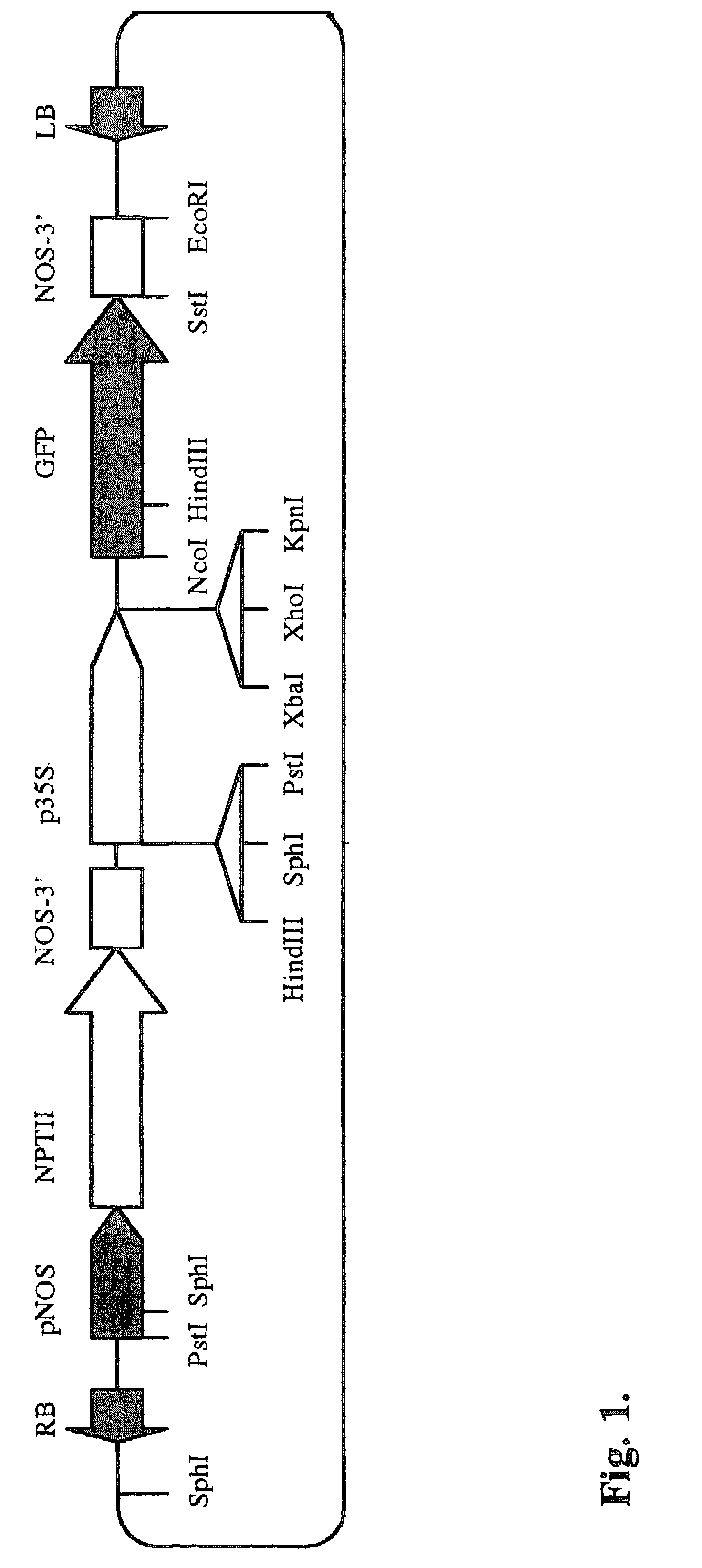High-efficiency Agrobacterium-mediated transformation of cotton using petiole explants
a technology of agrobacterium and cotton, applied in the field of high-efficiency agrobacterium-mediated transformation of cotton using petiole explants, can solve the problems of major obstacles, questionable validity of octopine as a marker for transformation, and lack of high-efficiency plant regeneration methods
- Summary
- Abstract
- Description
- Claims
- Application Information
AI Technical Summary
Benefits of technology
Problems solved by technology
Method used
Image
Examples
example 1
Agrobacterium Strain and Plasmids
[0084]A. tumefaciens strain LBA 4404 (pBI121GFP) was used for transformation of cotton petiole and young stem. The physical map of pBI121GFP is shown in FIG. 1, which contains GFP as a reporter gene and NPTII gene (encoding neomycin phosphotransferase) as a selectable marker. The GFP and NPTII genes are under the control of CaMV 35S promoter and nos promoter respectively.
[0085]For construction of pBI121GFP, a 720 bp XbaI-SstI fragment of GFP gene from the pGFP2 plasmid (from Dr. N. H. Chua, Rockefeller University, New York) was cloned into the same sites in plasmid vector pBI121 (Clontech) to replace the GUS gene. The pBI121GFP plasmid was introduced into A. tumefaciens LBA 4404 by electroporation.
example 2
Plant Material
[0086]Upland cotton varieties Coker 312 from the U.S.A. and Si-Mian 3 from Shanxi Cotton Research Institute in China were used in the experiments.
[0087]Tender petioles were collected from plants 8-12 weeks old grown in a greenhouse with low light conditions. The petioles were surface-sterilized with 70% ethanol for a few seconds, followed by 20% bleach solution (Clorox Co. USA, 1% available chlorine) for 20 min. After rinsing five times in sterilized water, the petioles were pre-cultured in MS medium for 3 days.
example 3
Plant Transformation
[0088]A single colony of A. tumefaciens strain LBA 4404 (pBI121GFP) was inoculated in liquid LB medium with 50 mg / L Rifampicin, 50 mg / L kanamycin and 100 mg / L streptomycin. The bacteria was grown overnight at 28° C. in a shaker of 200 rpm. The bacterium cultures were diluted using liquid MS medium to OD600=0.3.
[0089]The petiole and young stem were cut into about 2 cm long segments. The segments were soaked in the diluted bacterium suspension for 5 min, then transferred onto plastic plates (100×25 mm) containing a filter paper soaked in 50 ml of co-culture medium. The plates were kept in an incubator of 24° C. under continuous light for 48 hrs. The co-cultured explants were transferred onto MMS1 medium and incubated at 28° C. with 16 hrs light (60-90, μEm−2s−1) and 8 hrs dark per day. After 2-4 weeks calli were initiated at the cut ends of petiole segments. After 4-6 weeks kanamycin resistant calli had appeared, and the number of calli were counted and the express...
PUM
| Property | Measurement | Unit |
|---|---|---|
| Time | aaaaa | aaaaa |
| Time | aaaaa | aaaaa |
| Concentration | aaaaa | aaaaa |
Abstract
Description
Claims
Application Information
 Login to View More
Login to View More - R&D
- Intellectual Property
- Life Sciences
- Materials
- Tech Scout
- Unparalleled Data Quality
- Higher Quality Content
- 60% Fewer Hallucinations
Browse by: Latest US Patents, China's latest patents, Technical Efficacy Thesaurus, Application Domain, Technology Topic, Popular Technical Reports.
© 2025 PatSnap. All rights reserved.Legal|Privacy policy|Modern Slavery Act Transparency Statement|Sitemap|About US| Contact US: help@patsnap.com

